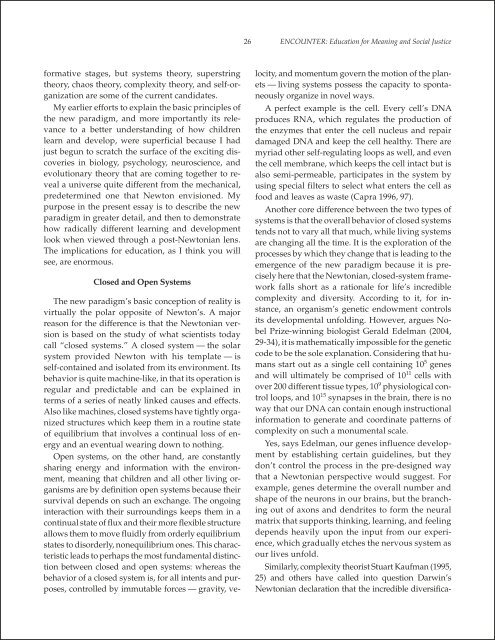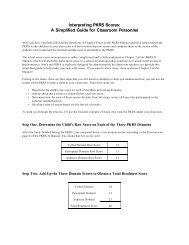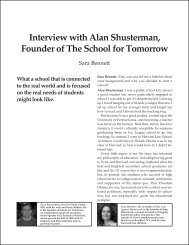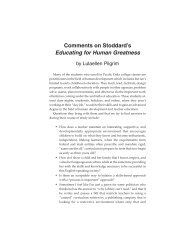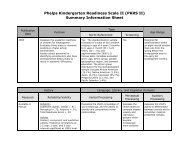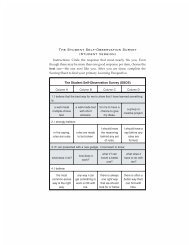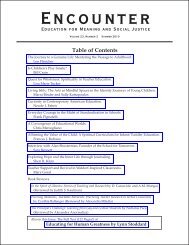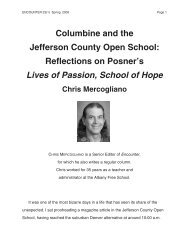Jane Goodall - Great Ideas in Education
Jane Goodall - Great Ideas in Education
Jane Goodall - Great Ideas in Education
Create successful ePaper yourself
Turn your PDF publications into a flip-book with our unique Google optimized e-Paper software.
26 ENCOUNTER: <strong>Education</strong> for Mean<strong>in</strong>g and Social Justice<br />
formative stages, but systems theory, superstr<strong>in</strong>g<br />
theory, chaos theory, complexity theory, and self-organization<br />
are some of the current candidates.<br />
My earlier efforts to expla<strong>in</strong> the basic pr<strong>in</strong>ciples of<br />
the new paradigm, and more importantly its relevance<br />
to a better understand<strong>in</strong>g of how children<br />
learn and develop, were superficial because I had<br />
just begun to scratch the surface of the excit<strong>in</strong>g discoveries<br />
<strong>in</strong> biology, psychology, neuroscience, and<br />
evolutionary theory that are com<strong>in</strong>g together to reveal<br />
a universe quite different from the mechanical,<br />
predeterm<strong>in</strong>ed one that Newton envisioned. My<br />
purpose <strong>in</strong> the present essay is to describe the new<br />
paradigm <strong>in</strong> greater detail, and then to demonstrate<br />
how radically different learn<strong>in</strong>g and development<br />
look when viewed through a post-Newtonian lens.<br />
The implications for education, as I th<strong>in</strong>k you will<br />
see, are enormous.<br />
Closed and Open Systems<br />
The new paradigm’s basic conception of reality is<br />
virtually the polar opposite of Newton’s. A major<br />
reason for the difference is that the Newtonian version<br />
is based on the study of what scientists today<br />
call “closed systems.” A closed system — the solar<br />
system provided Newton with his template — is<br />
self-conta<strong>in</strong>ed and isolated from its environment. Its<br />
behavior is quite mach<strong>in</strong>e-like, <strong>in</strong> that its operation is<br />
regular and predictable and can be expla<strong>in</strong>ed <strong>in</strong><br />
terms of a series of neatly l<strong>in</strong>ked causes and effects.<br />
Also like mach<strong>in</strong>es, closed systems have tightly organized<br />
structures which keep them <strong>in</strong> a rout<strong>in</strong>e state<br />
of equilibrium that <strong>in</strong>volves a cont<strong>in</strong>ual loss of energy<br />
and an eventual wear<strong>in</strong>g down to noth<strong>in</strong>g.<br />
Open systems, on the other hand, are constantly<br />
shar<strong>in</strong>g energy and <strong>in</strong>formation with the environment,<br />
mean<strong>in</strong>g that children and all other liv<strong>in</strong>g organisms<br />
are by def<strong>in</strong>ition open systems because their<br />
survival depends on such an exchange. The ongo<strong>in</strong>g<br />
<strong>in</strong>teraction with their surround<strong>in</strong>gs keeps them <strong>in</strong> a<br />
cont<strong>in</strong>ual state of flux and their more flexible structure<br />
allows them to move fluidly from orderly equilibrium<br />
states to disorderly, nonequilibrium ones. This characteristic<br />
leads to perhaps the most fundamental dist<strong>in</strong>ction<br />
between closed and open systems: whereas the<br />
behavior of a closed system is, for all <strong>in</strong>tents and purposes,<br />
controlled by immutable forces — gravity, velocity,<br />
and momentum govern the motion of the planets<br />
— liv<strong>in</strong>g systems possess the capacity to spontaneously<br />
organize <strong>in</strong> novel ways.<br />
A perfect example is the cell. Every cell’s DNA<br />
produces RNA, which regulates the production of<br />
the enzymes that enter the cell nucleus and repair<br />
damaged DNA and keep the cell healthy. There are<br />
myriad other self-regulat<strong>in</strong>g loops as well, and even<br />
the cell membrane, which keeps the cell <strong>in</strong>tact but is<br />
also semi-permeable, participates <strong>in</strong> the system by<br />
us<strong>in</strong>g special filters to select what enters the cell as<br />
food and leaves as waste (Capra 1996, 97).<br />
Another core difference between the two types of<br />
systems is that the overall behavior of closed systems<br />
tends not to vary all that much, while liv<strong>in</strong>g systems<br />
are chang<strong>in</strong>g all the time. It is the exploration of the<br />
processes by which they change that is lead<strong>in</strong>g to the<br />
emergence of the new paradigm because it is precisely<br />
here that the Newtonian, closed-system framework<br />
falls short as a rationale for life’s <strong>in</strong>credible<br />
complexity and diversity. Accord<strong>in</strong>g to it, for <strong>in</strong>stance,<br />
an organism’s genetic endowment controls<br />
its developmental unfold<strong>in</strong>g. However, argues Nobel<br />
Prize-w<strong>in</strong>n<strong>in</strong>g biologist Gerald Edelman (2004,<br />
29-34), it is mathematically impossible for the genetic<br />
code to be the sole explanation. Consider<strong>in</strong>g that humans<br />
start out as a s<strong>in</strong>gle cell conta<strong>in</strong><strong>in</strong>g 10 5 genes<br />
and will ultimately be comprised of 10 11 cells with<br />
over 200 different tissue types, 10 9 physiological control<br />
loops, and 10 15 synapses <strong>in</strong> the bra<strong>in</strong>, there is no<br />
way that our DNA can conta<strong>in</strong> enough <strong>in</strong>structional<br />
<strong>in</strong>formation to generate and coord<strong>in</strong>ate patterns of<br />
complexity on such a monumental scale.<br />
Yes, says Edelman, our genes <strong>in</strong>fluence development<br />
by establish<strong>in</strong>g certa<strong>in</strong> guidel<strong>in</strong>es, but they<br />
don’t control the process <strong>in</strong> the pre-designed way<br />
that a Newtonian perspective would suggest. For<br />
example, genes determ<strong>in</strong>e the overall number and<br />
shape of the neurons <strong>in</strong> our bra<strong>in</strong>s, but the branch<strong>in</strong>g<br />
out of axons and dendrites to form the neural<br />
matrix that supports th<strong>in</strong>k<strong>in</strong>g, learn<strong>in</strong>g, and feel<strong>in</strong>g<br />
depends heavily upon the <strong>in</strong>put from our experience,<br />
which gradually etches the nervous system as<br />
our lives unfold.<br />
Similarly, complexity theorist Stuart Kaufman (1995,<br />
25) and others have called <strong>in</strong>to question Darw<strong>in</strong>’s<br />
Newtonian declaration that the <strong>in</strong>credible diversifica-


